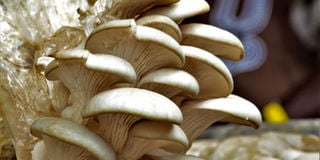Make Shs20m a year growing mushrooms

Oyester mushrooms ready for harvest at Ssekubunga’s farm. Photo by George Katongole.
What you need to know:
- Producing mushrooms is one of the farming ideas that require little capital and equally small space yet it is a simple pet activity that can be done for profit. The changing dietary habits of people in urban areas is offering a healthy market, writes George Katongole.
- Commercial farming in Uganda started in 1989 following the government introduction of oyster mushrooms from Egypt to the National Agricultural Research Laboratories (NARL) Kawanda.
An increasing number of people are growing mushrooms for nutritional, economic, and medicinal purpose.
There are more than 20 commercially produced varieties of mushrooms but oyster mushrooms are the most popular in Uganda because of the high market demand. This variety is also pretty simple to grow.
High in fibre and vitamins, mushrooms are also fat and cholesterol-free. They are increasingly becoming popular due to their versatility as well as their meat-like heft.
Oyster mushrooms are revered for being an excellent source of essential amino acids, vitamins and minerals. Oysters are also rich in zinc, which is essential for testosterone production and maintenance of healthy sperm.
On top of providing health benefits, for most growers mushroom cultivation is a fun low-cost hobby.
Since it does not require access to land, mushroom cultivation is a viable and attractive activity for both rural farmers and peri-urban dwellers. Small-scale growing does not require any significant capital investment.
In theory, mushroom growing requires keeping plants humid. In reality, there are a few twists and turns for profitability. Mushroom growing is quite labour-intensive but it’s a low cost activity suitable for low capital start-ups.
Oyster mushrooms take about six weeks from start to harvest, so it’s possible to make a big profit quickly.
Essential maths
If you have a 46-square foot growing area, that can produce about five tonnes of mushrooms in a year. Going by the current market price for a kilogramme of mushroom, you could earn Shs20m when you sell 5,000 kilogrammes each at Shs4,000. This could be a new career worth considering.
Mushrooms are ready to sell after about six weeks and the most convenient way is to try to sell them as soon as possible. But in case that is not possible, they can be frozen or dried. Mushrooms have a high water content of around 90 per cent, so drying them (12 per cent moisture) is an effective way to prolong their shelf-life and preserve their flavour and nutrients. There are three major selling options, farmers’ markets, restaurants and grocery stores.
If your mushrooms are fresh, healthy and delicious, then you could be in for business.
Roger Ssekubunga, a mushroom farmer in Makindye, who also deals in value addition as well as mother spawn grain master and mushroom seeds, oyster mushrooms are ideal for poverty alleviation.
“Mushroom cultivation can help reduce vulnerability to poverty because they are fast yielding,” Ssekubunga says.
Starter capital
Setting up a simple mushroom house can cost about Shs300,000. A beginner should get a hand spray pump for sprinkling water onto gardens. Hand pumps can be obtained for Shs7,500.
A metallic drum, preferably 200 litres, for holding water and boiling substrates costs an average of Shs60,000 while gunny bags for holding substrate during boiling cost about Shs10,000.
A farmer needs black polythene materials for darkening the incubation area. These can be obtained at Shs5,000 while nylon strings for hanging up gardens can take an estimated Shs3,000 and 20-litre jerrycans can be available for Shs20,000. The basic starter capital is Shs405,500.
Variable costs
Other costs include disinfectants, quality polythene bags whose pack costs Shs6,000.
Mushroom growing does not require use of fertilisers yet growth substrates may include major crop
residues of cereals, legumes, tree leaves, saw dust, coffee husks, banana leaves, sugarcane bagasse, cotton waste, cotton seed hull, brewer’s waste, papyrus reeds and elephant grass. The most commonly used are cotton hulls or crushed maize combs. A beginner may require about 35 kilogrammes which are estimated at Shs25,000.
Ready-to-inoculate spawns (4-5 kilogrammes) cost Shs50,000. 500g of building lime are available for Shs250. Two kilogrammes of nutritional supplements especially wheat, rice, or maize bran are Shs1,200 with firewood or charcoal worth Shs5,000 and 100 litres of water and toothpicks for poking holes.
For proper colonisation, the gardens must be watered daily with a minimum of 20 litres for two months. Ssekubunga stresses that farm records are an essential standard practice in food processing in order to monitor stock, production and easy management. Therefore, data must be captured in real time.
“Mushroom production records are particularly important in identifying key constraints,” he explains.
Caring for mushrooms
To grow a bumper crop, oyster mushrooms need a growing room where you can control the temperature, the humidity and the light throughout the growing cycle.
One of the keys to successful mushroom growing business is proper hygiene because contamination can be very disastrous.
Disinfectants and bleaching solutions are a major requirement on top of proper hand washing before handling any items like spawns and substrates.
Ssekubunga says that in order “to obtain a very good mushroom production you need to water the gardens frequently especially in the early hours of the day.”
Common challenges
Ssekubunga says that mushrooms are hardly attacked by diseases but pests such as insects, snails and rodents are a common nuisance in mushroom houses and dark rooms.
These are managed through improving housing conditions. The mushroom house can be made vermin proof while insects are repelled by smoking the house once a week.
Mushrooms tend to fruit at different times.
But according to Ssekubunga, bags should be moved to cool places to enhance a white, fluffy-looking mycelium appearing between seven and 14 days. Poor hygiene during incubation can lead to abnormal fungi growth.
He recommends destroying or removing infected materials while advocating for sourcing of spawn from quality producers.
History
Traditionally, people picked mushrooms, a wild edible fungi, in forests, grasslands and woodlands including around termite mounds where conditions favour their growth. Mushrooms are considered a delicacy because of their unique flavour. Commercial farming in Uganda started in 1989 following the government introduction of oyster mushrooms from Egypt to the National Agricultural Research Laboratories (NARL) Kawanda.




